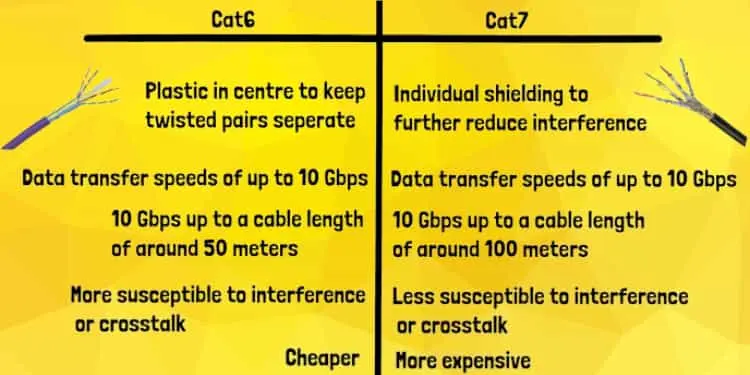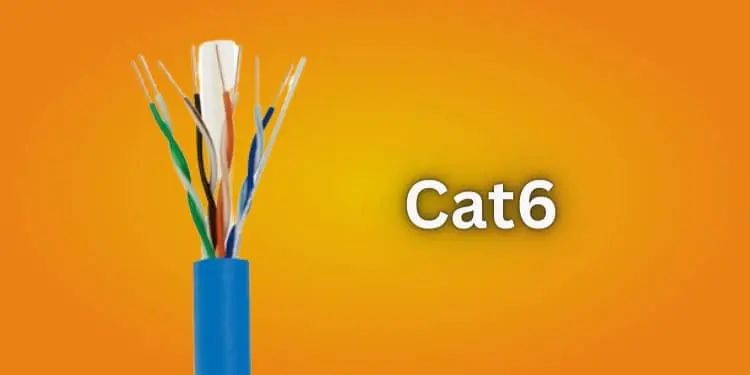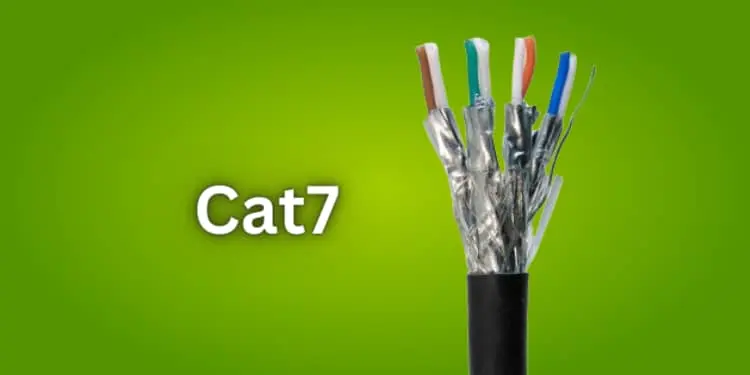Cat6 vs Cat7 [Quick Comparison 2025]
Modern networking relies on Ethernet cables to transfer data between devices. From the many alternatives, Cat6 and Cat7 stand out for their distinct characteristics and capabilities. Explore detailed analysis of Cat6 vs Cat7 to learn more about Ethernet cables. Discover speed, shielding, and pricing differences to choose a networking solution. Learn about Cat6 and Cat7 specs, pros, and cons to improve your connectivity.
Cat6 vs Cat7
| Feature | Cat6 | Cat7 |
|---|---|---|
| Speed | Up to 10Gbps | Up to 10Gbps |
| Shielding | UTP, STP | SSTP |
| Bandwidth | 250MHz | 600MHz |
| Length | 55 meters | 100 meters |
| Cost | $0.30 per foot | $0.50 per foot |
| Connectors | RJ45 | GG45/ARJ45 |

What is Cat6?

Cat6, standing for Category 6, is a significant Ethernet cable upgrade above Cat5e. Its speed, bandwidth, and performance advantages are popular for home and commercial networking.
Specifications:
- Speed: Cat6 cables support 10 Gbps connections up to 55m, enabling fast data transfers and seamless connectivity.
- Shielding: UTP and STP Cat6 cables protect against electromagnetic interference to varying degrees.
- Bandwidth: With 250MHz capacity, Cat6 cables can easily carry huge volumes of data.
- Maximum Length: Cat6 cables may reach 55 meters, connecting most networking installations.
- Cost: Budget-conscious users choose Cat6 cables since they’re cost-effective and operate well.
Pros:
- Affordability: Cat6 cables are affordable and offer a combination of performance and cost, making them accessible to many customers.
- Decent Performance: Cat6 cables suit common networking application needs with high speeds and bandwidth.
- Versatility: Cat6 connections operate with previous Ethernet standards, making integrating them easy.
- Availability: Cat6 cables are widely available, making them convenient and accessible to consumers globally.
Cons:
- Limited Reach: One limitation of Cat6 cables is their limited transmission distance of 55 meters, which may limit their use in larger networking configurations despite their high performance.
- Moderate Shielding: Cat6 cables insulate against electromagnetic interference, although performance may suffer in high-interference areas.
What is Cat7?

Category 7 Ethernet cables are the best in performance and dependability. It redefines networking standards for demanding applications that require speed and stability.
Specifications:
- Speed: Cat7 cables can transport data at 10 Gbps, making it blazing fast.
- Superior Shielding: Cat7 cables use SSTP shielding to avoid electromagnetic interference and maintain communication in extreme conditions.
- Extended Bandwidth: Cat7 cables accommodate massive data loads with 600MHz bandwidth, making them excellent for data-intensive applications.
- Extended Reach: Cat7 cables can transmit up to 100 meters reliably, allowing network layout and design flexibility in bigger infrastructures.
- Cost: Due to their advanced technology and structure, Cat7 cables cost more than Cat6 but function better.
Pros:
- Unrivaled Performance: Cat7 cables offer superior speed, bandwidth, and dependability, making them ideal for high-performance networking environments.
- Future-Proofing: Cat7 cables are ready for future networking technology advances, protecting infrastructure investments.
Cons:
- Higher Cost: Cat7 cables are expensive due to their sophisticated features and performance, which may alienate budget-conscious users.
- Limited Availability: Cat7 cables perform better than Cat6 cables, but they may be harder to get, especially in some countries.
FAQs
Is Cat7 good for gaming?
Due to its speed, bandwidth, and protection, Cat7 provides low latency and uninterrupted gaming.
Is Cat6 or Cat7 better for the home?
Cat7 is best for streaming, gaming, and smart home device home networks that need fast, dependable connectivity. However, Cat6 may be cheaper for simple networking.
Is Cat7 expensive?
Due to their advanced features and design, Cat7 cables cost more than Cat6 but perform better and are more reliable.
Conclusion
The strengths of Cat6 and Cat7 satisfy diverse networking needs. Cat6 is cost-effective and performs well for most users, but Cat7’s speed, bandwidth, and dependability make it the best choice for demanding Apps. Personal needs, money, and networking environment determine Cat6 or Cat7.






